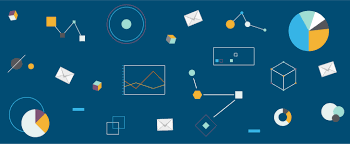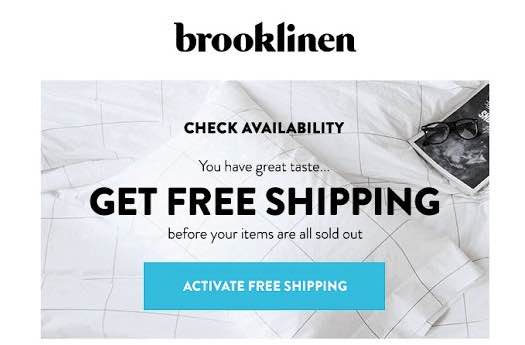Hello!
Email marketing is a must-have for keeping in touch with your customers and prospects. Not only is it easy to do, but it’s inexpensive and brings in a substantial ROI. In fact, for every $1 spent to send emails, the return is $44.
With an average of 111 emails hitting consumers’ inboxes each day, it’s important to find creative ways to stand out to your subscribers. But, how do you do this, especially if you’re limited by time and budget? Many marketers rely on their data.
 Data-driven email marketing isn’t new, people have been using it for adding names to email subject lines for some time, but with technology and tools available to marketers now, it’s more than just a passing fad, it can be crucial to help your emails be successful.
Data-driven email marketing isn’t new, people have been using it for adding names to email subject lines for some time, but with technology and tools available to marketers now, it’s more than just a passing fad, it can be crucial to help your emails be successful.
With information, or data, you already know about your subscribers, you can use it to create compelling emails with exactly the right message for each one.
This will take your email marketing to the next level. You can send personalized emails with specific information directed to each person on your list or easily create segmented lists to target specific groups of people. And it all can be done by using or collecting a little bit of data.
Leveraging data isn’t always straightforward, though. Eighty-one percent of marketers say that implementing a data-driven email strategy can be complicated. That’s why we’re sharing some tips and ideas to get you started.
Create a plan
Before you make any changes to your current email marketing strategy, you’ll need to think about how you want to leverage data. Data-driven email marketing is meant to augment what you’re doing already, and then help you grow the effectiveness of your email marketing. So take a look at some of these ideas and start adding them over time, not all at once.
Consider what your marketing goals are, and consider how you can use and collect data to reach these goals. For example, if you want to increase customer retention, you might need to collect data about how often users are making a purchase, what they’re buying, as well as how much they spend.
If you’re looking to change your conversion rate you’ll want to know what and how much information someone needs to make a purchase, how long it takes to make that decision, and any barriers they may have. With this information, you can then figure out how many emails it will take to help them get there. This kind of data can then be used to inform email campaigns.
 In the beginning, you may want to segment your lists into different groups that are pertinent to your business and marketing plan. Try setting up lists based on your customer lifecycle- putting subscribers into categories based on whether they’re a lead, have made a purchase, or are a brand advocate.
In the beginning, you may want to segment your lists into different groups that are pertinent to your business and marketing plan. Try setting up lists based on your customer lifecycle- putting subscribers into categories based on whether they’re a lead, have made a purchase, or are a brand advocate.
Once you’ve gotten the hang of creating and using segmented lists, you can build ones that are even more detailed which have the potential for cultivating even more engaged customers.
Data-driven email marketing isn't only about list building. In addition to creating specific email lists, you can also use data to personalize the emails you send. Starting with an email subject line is a good place to begin down this path, as emails with a personalized subject line are 26% more likely to be opened. Subject lines, however, are just the beginning. You can add information based on purchases from the past, clothing size, or even images based on your reader’s gender.
Gather data
If you want to know how to use data to grow your business, you need to be able to gather and collect the right data. Once you have an idea of what you want to do with the data you collect, you need to collect it. There are different ways to collect information. Sometimes it’s a matter of harvesting information you already have, while other times you’ll need to ask subscribers for info.
A good place to start is with the data you get from your email service provider. You’ll have information about who opens your email, when they do it, what links they click on, and where they are when they get your messages. You can also track who’s making purchases, what they buy, and when. With this small amount of data, you can begin to segment your lists and create personalized messages.
 Beyond data from your email campaigns, you can collect data from other resources as well. Most companies with a website have access to Google Analytics, which can collect a lot of details about website visitors.
Beyond data from your email campaigns, you can collect data from other resources as well. Most companies with a website have access to Google Analytics, which can collect a lot of details about website visitors.
This can be a great way to find out things like visitor location, products they’re interested in (based on pages viewed), and other useful information.
Another way to collect the data you need is to send a survey via email or share it on social media or even as a pop-up on your website. You can even change your sign-up forms to collect the more pertinent information, not just a name and email address.
And don’t forget to check with people on your team or in other parts of your company for additional sources of data. To start with your data-driven email marketing campaigns, find out what your sales team, IT department, and engineers already know about your subscribers and customers. All can be great, untapped resources to help create more data-driven marketing.
Implement
Creating segmented lists will likely be your first step to data-driven email marketing. Set up your lists using the criteria you’ve decided will work best for your marketing needs.
Many marketers segment their lists by:
• Gender - Not only can you share specific products this way, but also send email campaigns that appeal to your reader’s interests.
• Location - Knowing what region, city or zip code your customers live in can allow you to send emails based on a snow storm they’re experiencing or local events.
• Purchase history - Can help you to know what your customer needs in the future that you can include in emails.
• Interests - This can range from personal hobbies to how they use your products.
• Level of engagement - Knowing how interested someone is in your business can help you make sure you’re sending emails to help keep them engaged.
 Once your lists are segmented the way you want them, you can start to personalize the emails you want to send. By creating personalized, individualized messages, you show your subscribers that you’re paying attention to who they are and what’s important to them.
Once your lists are segmented the way you want them, you can start to personalize the emails you want to send. By creating personalized, individualized messages, you show your subscribers that you’re paying attention to who they are and what’s important to them.
Try experimenting by including images and videos that are personalized for each email recipient.
If you have your subscriber’s first name, location, or even t-shirt size in your email list, and you probably do, then you can use that information to personalize the text in your email campaigns, not just the subject line. If you don’t have this data, then you know you’ll need to add it to your email sign-up form for future email campaigns.
For example, Adidas creates gender-specific campaigns to target specific segments of their audience. Depending on the gender-identification of the person who’s receiving it, they received a message promoting either women’s or men’s clothing, but not both.
 Many companies segment their lists based on purchase history. By using a customer’s recent purchase or products they’ve looked at from your website, you can use your customers’ own behavior to create more relevant emails that can drive purchases. A great example is to use a cart abandonment email strategy to increase your sales.
Many companies segment their lists based on purchase history. By using a customer’s recent purchase or products they’ve looked at from your website, you can use your customers’ own behavior to create more relevant emails that can drive purchases. A great example is to use a cart abandonment email strategy to increase your sales.
For example, Brooklinen sends an data-driven email marketing campaigns based on website behavior. The message includes images of the products that the subscriber had recently browsed, but had not yet purchased. Brooklinen included a free shipping incentive to help encourage the subscriber to make a decision.
As with everything in marketing, you’ll need to test out how each type of personalization works for your subscribers. Keep an eye on your email opens, clicks, and purchases, to see what kind of impact you’re making. Being data-driven will help you boost your email marketing ROI.
If you’re making changes to your email marketing strategy it’s really important to know the level of engagement in your emails before you start adding in these changes. This will be the data you get from each email you’ve sent from your email service in the past. Create a benchmark of what your average open, click, purchase and unsubscribes are first, then add in your changes. This will make it easier for you to see how personalization is changing how your customers interact with your email.
So, how data-driven email marketing will help your business grow?
Using data-driven email marketing is a powerful way to keep email subscribers engaged with your brand. By creating campaigns that speak directly to each individual, subscribers will be more likely to open emails, click-through to your website, and ultimately make purchases.
You should use data for your marketing strategy but watch out and don't make those data-driven marketing mistakes: be patient, collect enough data, experiment, etc... If you’re not already using data, you’ll want to start out slowly. Assess what you already have in your business resources and then think about what you want to do and how to make that work. It won’t happen overnight, but you can make changes that have a positive impact on your bottom line.
There are many email marketing growth hacks you can use for your startup or business. By making just a few changes to your email strategy you can make a big change in how your brand is perceived by your customers. And in turn, they’ll be more eager to open your emails when they come to their inbox, setting your brand apart from the crowd.
Thank you!
Subscribe to our newsletter! Join us on social networks!
See you






